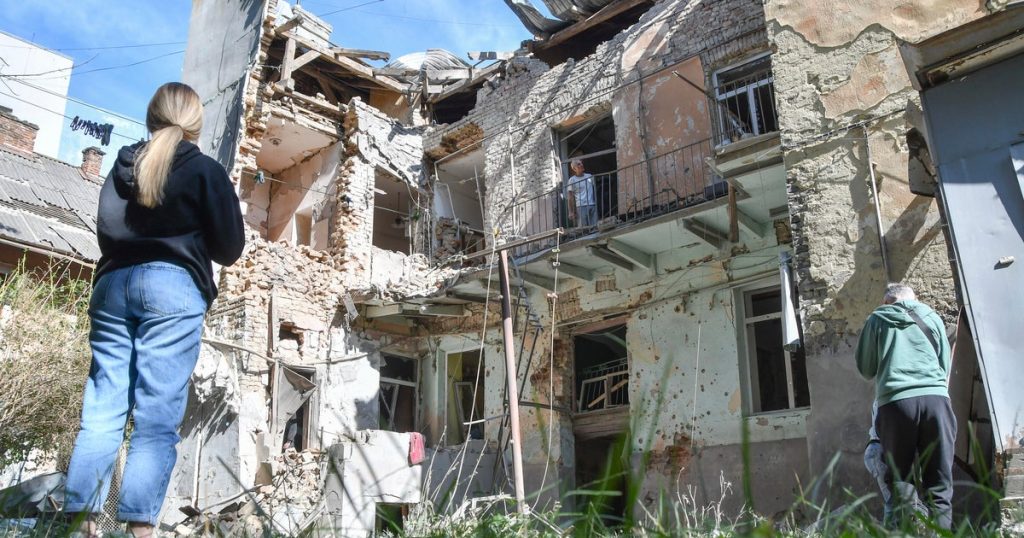In a significant escalation of hostilities, Russia has intensified its air assaults on Ukraine with drone and missile attacks, resulting in the deaths of at least six individuals over the weekend. The recent violence underscores the ongoing volatility of the conflict, which has now dragged on for more than three years. As Ukrainian cities endure the bombardment, hopes for a diplomatic resolution continue to wane amid rising casualty figures.
| Article Subheadings |
|---|
| 1) Overview of Recent Attacks |
| 2) Casualties and Regional Impact |
| 3) International Response |
| 4) Russia’s Strategic Objectives |
| 5) Future Implications for the Conflict |
Overview of Recent Attacks
In the early hours of Saturday morning, Russia unleashed a severe offensive against Ukraine, involving the deployment of 597 drones and 26 cruise missiles. Ukraine’s air force reported that a significant number of these were intercepted, with 319 drones and 25 missiles shot down, while 258 decoy drones were believed to have been lost to electronic jamming. This aerial onslaught marks the latest phase in Russia’s sustained campaign against Ukrainian infrastructure and civilian areas, intensifying fears among the populace.
Casualties and Regional Impact
The lethal impact of these attacks was starkly evident as at least six people lost their lives and many others suffered injuries across various regions. In the Bukovina area of the Chernivtsi region, two individuals died due to debris from a drone strike. Simultaneously, a drone attack in the Lviv region injured nine others, and Kharkiv faced similar trials with three wounded amid multiple strikes. In another tragic instance, two people were killed in the Dnipropetrovsk region due to a missile strike, while two more died from a guided bomb in the Sumy region. This cascade of violence highlights the deepening humanitarian crisis as civilians bear the brunt of the ongoing conflict.
International Response
In light of the escalated air attacks, international responses are starting to take shape. Poland has activated its air force, deploying fighter jets in areas close to its border with Ukraine following the drone incursions. This move comes as Poland recognizes the threat posed by the proximity of conflict and has bolstered its defensive measures in preparation for potential spillover. Global leaders have increasingly called for urgent diplomatic efforts to restore peace, although substantial progress remains elusive amidst the continuing violence.
Russia’s Strategic Objectives
These aggressive actions are viewed by analysts as part of a broader strategy by Russia to gain ground on the battlefield and weaken Ukraine’s defensive capabilities. As Russian forces escalate their long-range strikes, they aim to disrupt not only military operations but also the logistical channels that bring crucial foreign military aid to Ukraine. The tensions at the roughly 1,000-kilometer front line indicate the urgent need for both sides to reassess their military strategies as Ukraine’s forces face intensified pressure and logistical challenges.
Future Implications for the Conflict
The weekend’s attacks serve to highlight the war’s trajectory and foreshadow potential escalations in the coming days. With Russia’s continuous barrage on Ukrainian cities, expectations for a peaceful resolution are further dwindling. The ongoing humanitarian toll risks galvanizing both domestic and international support for Ukraine, potentially attracting more military assistance. Conversely, the potential for backlash within Russia against the prolonged conflict may also rise. Ultimately, the situation remains fluid, and every increment of violence brings unknown implications for both the short-term and long-term future of the region.
| No. | Key Points |
|---|---|
| 1 | Russia launched a large-scale aerial attack involving over 500 drones and missiles. |
| 2 | The attacks resulted in at least six fatalities and numerous injuries across multiple regions. |
| 3 | International responses are emerging, including an increase in Polish military activity along the border. |
| 4 | Russia’s strategy appears focused on debilitating Ukraine’s military capabilities and disrupting foreign aid logistics. |
| 5 | The ongoing violence raises critical questions about the future course of the conflict and humanitarian implications. |
Summary
The recent surge in Russian air assaults on Ukraine highlights the deteriorating humanitarian and military landscape as the conflict drags on. With increasing casualties and international reactions, the implications of these events could further complicate the path to peace. Analysts underline that both the sustained violence and strategic objectives driven by Russia pose significant challenges for short-term stability, raising urgent questions about the war’s trajectory.
Frequently Asked Questions
Question: What triggered the recent escalation in attacks by Russia?
The escalation appears to be part of a larger strategic objective by Russia to increase its military pressure on Ukraine, targeting cities with increased drone and missile strikes.
Question: How are Ukrainian forces responding to the air assaults?
Ukrainian air forces have successfully intercepted a significant number of incoming drones and missiles; however, the attacks underscore the ongoing threat to civilian areas and military infrastructure.
Question: What international responses have been observed in light of these attacks?
In response to the aerial bombardments, Poland has scrambled fighter jets near its border with Ukraine, reflecting mounting regional concerns about spillover effects from the conflict.


